
views
Using the Basic Organization Methods

Keep it simple. The point of creating a filing system is to make things easier on yourself. You'll want to avoid making your system overly complicated or confusing. Keeping your system as simple as you can will help you easily file or retrieve whatever documents you might need to work with. Only file away what you need. Storing too much can make your system clunky and hard to use. Avoid needless complexity in your file system. Throw away files that you are sure you no longer need.
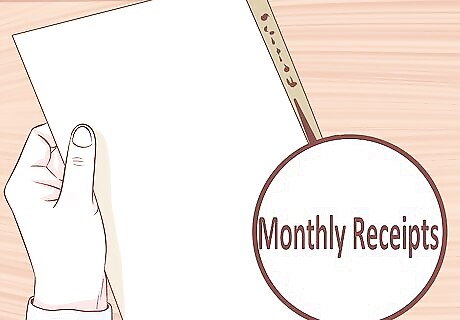
Use the right amount of depth in your system. It might be tempting to create a lot of different categories and subcategories for your files to fit in. However, it's a good idea to only make broad level categories and to use only as many as you absolutely need. Creating too many categories can result in a clunky and inefficient filing system. Make sure you create the right amount of organizational depth in your system to keep it working smoothly. Avoid making overly detailed sub-categories for your system. For example, “Receipts, Food, Bread” would be far too detailed to be useful. Simply having a category for monthly or weekly receipts might be more appropriate for your filing system. Having a section for clients and then arranging them in alphabetical is an example of an effective level of depth.
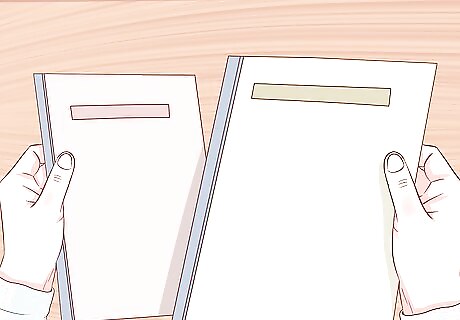
Make your files easy to find. Your filing system will benefit greatly from having obvious visual cues that let you know exactly where something is stored. Making the sections of your file system obvious will help you quickly locate an item or file one away. Keep some of these tips in mind when making your files stand out: Use colored folders to indicate certain categories or sections. Try keeping a handy list of the colors and the categories you have assigned to them. Use a label maker to clearly label your files. Keep track of the cut of your folders. Try using only one folder cut for each category or section.

Think about the types of file containers you'll need. Before you can organize your files, you'll need to find something to put them. Exactly which type of file containers you use will depend on the amount of files you have to store, how important they are, the dimensions of the documents, and the frequency with which you need to access them. Take a look at some of these tips to get an idea of which file containers might be right for you: If you need to store very important documents, consider purchasing a fire proof storage container. Finding the Underwriters' Laboratory seal on a container can indicate that the container will protect your files for about an hour in a fire with temperatures of 1700 degrees Fahrenheit. For regular files, you may want to purchase a basic filing cabinet. For sensitive or confidential files, consider purchasing a more secure filing cabinet or a safe. You'll want to make sure your filing container has enough room to hold all of your files. If you have any unusually sized documents, check that they will be able to fit in your storage container. Fore example, legal-sized documents may affect the size of folder needed as well as the storage dimensions.
Organizing Your Documents

Gather up all of your documents. Before you can get started organizing your documents, you'll want to make sure you've got all of your documents in front of you. Don't worry about how your files are organized or arranged just yet. For now, gather up all the documents you think need to be stored and get ready to sort them. Take out older documents that you have already sorted. You may want to rearrange them to fit in with the new system that you're creating. Make sure you've got all of your recent documents collected and ready to be sorted.
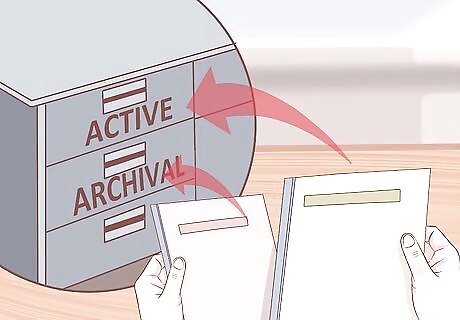
Sort your files into active and archive items. When you are organizing your files, it can be helpful to form them into two main categories: active files that you need to work with and archival files that you need to store away. This will help you access the files you use more often and neatly store away the files you won't be needing immediate access to. Active files are documents that you still need to address, reference or otherwise access often. Archival files are documents that you won't need in the near future, but still need to save.

Create and label the right categories for your system. After you've gotten your files together in one place, you can take a quick inventory of them. While you are reviewing your files, take note of the general categories they might fit. Write these categories down to create the basic organizational system that you will be using for your files. Take a look at some of these common categories to get an idea of which ones you might want to use: Legal records with subcategories such as birth certificates, death certificates or marriage documents. Financial documents that cover your past financial summaries, credit card information, credit reports or annual financial summaries. Property records. Personal documents such as diplomas, employment records, health records and insurance policies.

File long term storage documents away. Put documents that you've labeled as archival files into your long term storage container. These files won't be accessed often, so make sure they are placed into their proper categories in the filing system for later retrieval. Archival files will likely make up the majority of your filed and organized documents. Long term storage can be divided into two further categories: permanent files and “dead” files. Permanent files might include educational documents, employment documents or other important papers that you may still need to access. ”Dead” files are documents that you may not need to access again. Old tax records may fit in this category. Remember, however, that tax returns should be kept for seven years.
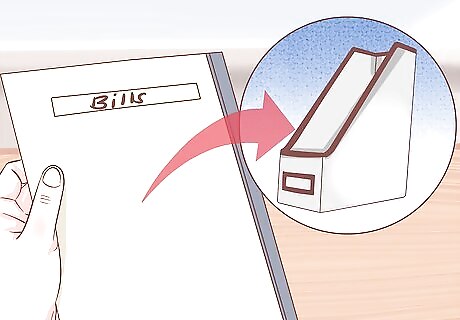
Put your current documents into your active document section. Documents that you will be using often or still need to review, will need to be placed into your active documents section. This section in your filing system will allow you to quickly access documents that are not quite ready for archiving. The following are the four most common active document categories that you might consider using: Documents that still need your attention. Documents that you still need to read or review. Bills that you still need to pay. Documents that are ready to move into long term storage.
Organizing Electronic Files
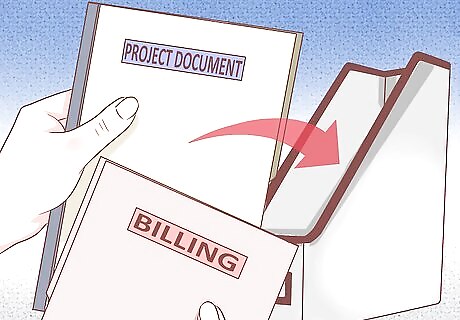
Start with broad categories then get more specific. Just like with your physical files, you'll want to start with the broadest categories that your files fit into. For example, if you are an independent contractor, you might want to organize your files by employer. That is, create one folder for each of them. Then, you should split your files up within each broad category into smaller ones. This means that your employer folders could be further split into different folders containing information about each project with that employer. Consider staying consistent within each broad category. This will make your files easier to find. For example, you could have the subfolder for each project contain files like "project documents", "billing," and "communications." You can also organize folders broadly by year if that seems easier or more relevant to your files.
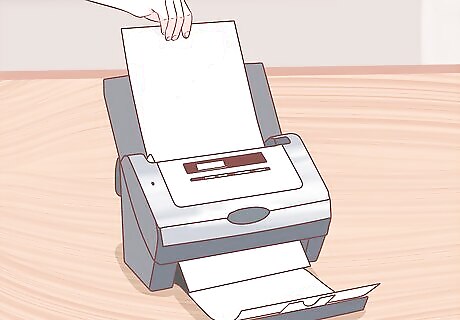
Scan or download files you don't already have electronically. It can be beneficial to have all of your files saved electronically in one place. Despite the time required, you should try to scan in as many of your physical documents as possible so that they can be electronically saved and backed up. In addition, make sure to download any files held online in other places, just in case the hosting website becomes inaccessible when you need the files again. Organize these files as you would any others.
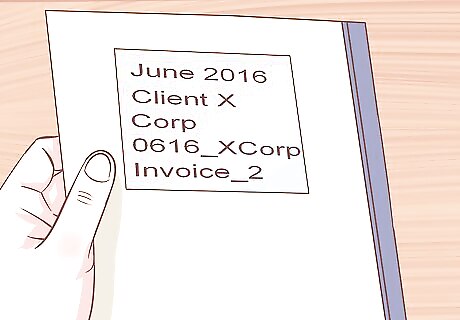
Give your files specific names. File names should be easily understandable and unique. That is, you should be able to look at your file names and immediately know what is contained in them. Try including a date, a signifier of the folders that will contain the file, and an individual descriptor. For example, a billing file created in June of 2016 for your client X Corp might be called "0616_XCorp_Invoice_2." This will allow you to know exactly what the file contains without taking the time to open it. Whatever system you use to name your files, just make sure to do so consistently. Once you've chosen a system, stick with it; it will be hard to go back and rename all of your files later.
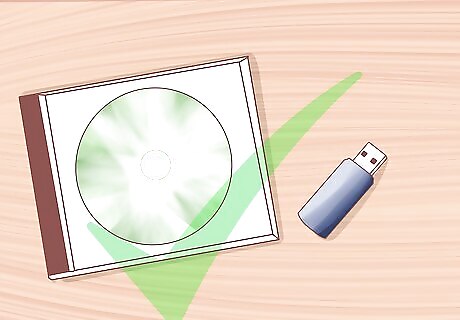
Back up your files regularly. The primary danger of electronic file keeping is that your information is susceptible to loss through a computer crash. Be prepared for this by regularly backing up your files to an online backup service, CDs, or an external hard drive. Be sure to label these storage devices as clearly as you have labeled your files. If you have an external drive or CDs, consider keeping them in a safe place away from your primary residence to avoid a total loss from a fire or natural disaster.
Maintaining Your Filing System
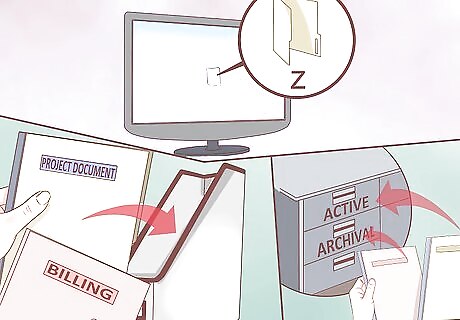
Keep up with your system. After you've created your filling system, you'll want to keep using it as you intended. Getting too far behind, ignoring items that need to be filed or improperly filing items can all undo the hard work you've put in. Make sure you're keeping up with your filing system to keep it working for you. Occasionally looking for files that are out of place can help keep your system in order. Don't neglect filing your active documents away in your archival document storage.
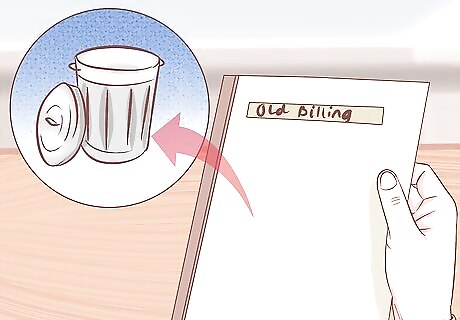
Remove old files. Some files are necessary to store away for a long period of time. However, your filing system will be finite in size and will require you to regularly remove files that are no longer needed. Regular weeding of your file system will help keep that system in order and functioning properly. Many old financial documents will need to be stored for years. Old budgets, financial statements or annual policies may need to be stored for only one year. Removing old files will create space for incoming documents. Getting rid of files that are not necessary will make it easier to find documents that you do need. The same goes for electronic files. Delete any duplicate, obsolete, or unnecessary documents from previous projects.
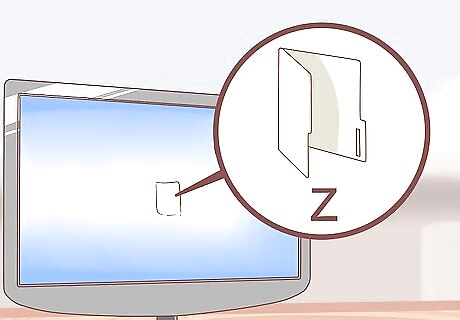
Archive old electronic files. Old files that are still relevant or may one day be referred back to can be archived. This means storing them away from your standard filing system but keeping them organized and accessible. Consider setting up an additional broad category for archived files. Move unused files to this folder with their subfolder formatting intact. If you want to keep archived files out of the way on your file screen, try placing a "z" in front of the file name so that it goes to the bottom of your alphabetic file order. For example, you could call it "z_archive" or something similar.

Streamline your filing system. Getting your files in order and keeping them that way can both be helpful when it comes to your personal organizing. However, there will always be room for improvement in your filing system. As you continue working with your filing system, keep an eye out for any improvements that you can make to help make it even more effective. You may want to get rid of categories that you don't seem to be using. Categories that seem to be overly used may need to be broken down into smaller categories.



















Comments
0 comment